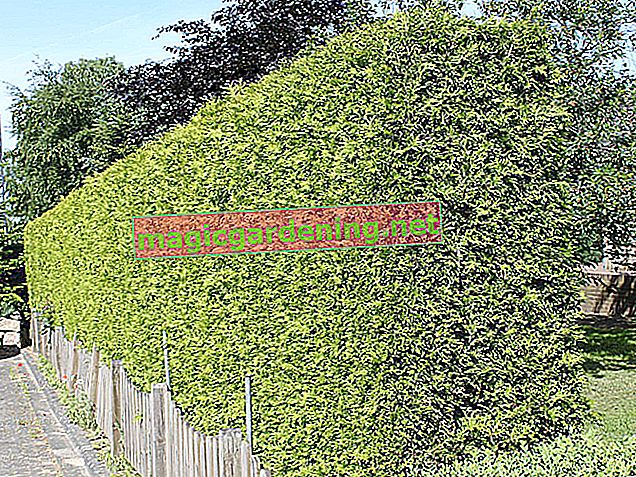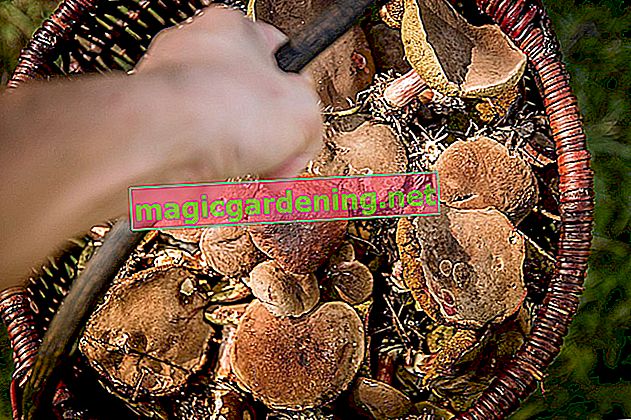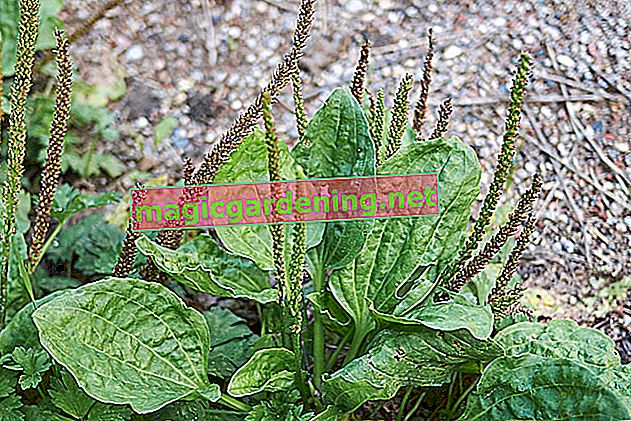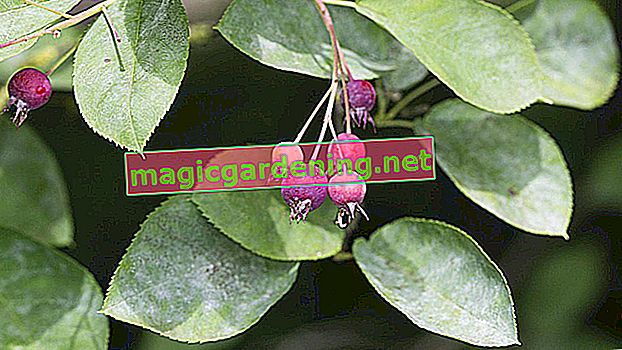
Plant black-eyed susanne properly
You can plant the black-eyed Susanne, which you have bought yourself or pre-purchased, in the bed or in the outdoor tub from mid-May. In advance, put the still potted root ball in soft rainwater until no more air bubbles rise. Meanwhile, prepare the ground in the sunny to partially shaded location by weeding weeds and removing roots and stones. So it goes on in the following:
- The planting pit is 1.5 times deeper and wider than the root ball
- Mix the excavation with leaf earth, compost and horn shavings
- Install the climbing support before the Thunbergia is potted and planted
- Tie the lower tendrils to the climbing aid and water them generously
also read
- Taking care of the black-eyed Susanne properly
- A climbing aid for the black-eyed Susanne
- The right location for the black-eyed Susanne
The planting proceeds in a similar way in the balcony box or tub, in which case a few potsherds under the substrate serve as drainage.
Care tips
In order to stage a shining sea of flowers with a Thunbergia, the following care is required:
- Water the plant well-balanced without causing drought stress or waterlogging
- Ideally, alternate between soft rainwater and tap water
- From May to October, fertilize organically or mineral-organically every 14 days
- Shorten 3 weeks after planting for bushy growth
- Brush the withered flower stalks several times a week
Considering a temperature minimum of 15 degrees Celsius, wintering a black-eyed Susanne turns out to be quite time-consuming, especially since the procedure is not always successful. If you have bright winter quarters with 15-18 degrees Celsius, you can try it. During the winter, there is little watering and no fertilization.
Continue reading
Which location is suitable?
The black-eyed Susanne feels extremely at home in the sunny to partially shaded, warm and wind-protected location. Ideally, the climbing plant is also protected from the pattering rain, such as under a roof overhang or a terrace. The tropical beauty does not make any capricious demands on the nature of the soil. The soil should be loose, humus and rich in nutrients and without the risk of waterlogging.
Continue reading
The correct planting distance
If you settle the black-eyed Susan in the group, you are exactly right with a planting distance of 50 cm. If the climbing artist acts as a summer ground cover, arrange 4-6 specimens per square meter.
What soil does the plant need?
Creative hobby gardeners cultivate the black-eyed Susanne as an annual climbing plant, preferably in a tub with an integrated climbing aid. So that the plant can develop its impressive volume of flowers and leaves quickly, we recommend a high-quality compost-based potted plant soil as a substrate. If the Thunbergia is used as a summer fence or facade greening, the soil should be humus, deeply loose and rich in nutrients.
What is the best time to plant?
The black-eyed Susanne comes from the tropical warm regions of Africa. Thus, the climbing plant does not tolerate frosty temperatures. The time window for the planting therefore opens in mid-May, when the ice saints have said goodbye.
When is the flowering time?
Thunbergia that are grown in the house and planted in May immediately start off with their blossoms. The flowering period extends into October as long as the temperatures are above the 15-degree mark. To ensure that the colorful appearance is not impaired and new flowers can open unhindered, withered shoots are cleaned regularly.
Cut black-eyed susanne properly
If you cut back the tendrils by a third after the first 3 weeks outdoors, the black-eyed Susan will thrive in a wonderfully bushy and compact manner. In addition, on a Thunbergia, the use of secateurs is limited to the regular cleaning of withered flower stems. If you carry out this maintenance measure routinely, the climbing plant will present a neat appearance throughout the summer and will maintain a constant willingness to flower. If you aim to harvest the seeds in autumn for sowing next year, leave a few flowers on the plant so that the approx. 20 mm long fruits can develop.
Pour black-eyed susanne
The black-eyed Susan evaporates abundant moisture from her lush mass of flowers and leaves. You should therefore water regularly as soon as the substrate dries up. Use soft rainwater and tap water alternately, as the tropical plant quickly suffers from an excess of lime. In addition, nutrient-rich pond water is ideally suited for watering. Please avoid that the plant is watered overhead. If you pour the irrigation water directly onto the roots with the nozzle of a jug, the world is all right for the climbing plant.
Black-eyed susanne fertilize properly
In order for the black-eyed Susanne to put on her opulent flowers and leaves, she needs a rich supply of nutrients. Fertilize the climbing plant every 2 weeks from May to October. In the bed, compost, horn shavings, (€ 6.39 at Amazon *) horse manure or guano (€ 10.44 at Amazon *) provide the necessary plant food. Liquid fertilizer for flowering plants is ideal in the planter due to its uncomplicated administration.
Overwinter
Since a black-eyed Susanne is already weak at temperatures below 15 degrees, we advocate annual cultivation. If, on the other hand, you have ample room capacity, you are welcome to try the wintering experiment. Pay attention to:
- Cut the plant back to 40-50 cm in autumn
- Put in a bright winter quarter with temperatures of 15-17 degrees Celsius
- Pour enough so that the root ball does not dry out
- Do not give fertilizer from November to March / April
Before the overwintered Thunbergia moves to the garden or balcony in May, repot in fresh substrate and a slightly larger bucket.
Continue reading
Increase black-eyed susanne
If you want to enjoy the lush flowers of a Thunbergia again next summer, you can choose from the following two methods of propagation:
- Cut cuttings from overwintered plants in February / March and let them take root in poor substrate
- Harvest the seeds in autumn, keep them dry and sow indoors from February
At this point, however, it should not be overlooked that the cutting method is rarely crowned with success. The chances of a successful sowing are significantly improved if you use certified seeds from the specialist trade.
Continue reading
Black-eyed susanne in the pot
In the pot with integrated climbing aid, the black-eyed Susanne proves to be a breathtaking privacy screen on the sunny balcony or at the sheltered seat in the garden. So that the blooms leave nothing to be desired, choose a high-quality compost-based potted plant soil as the substrate and add a few handfuls of lava granules (€ 10.95 at Amazon *). Place a few pottery shards over the water drain as an effective drainage system against waterlogging. How to properly plant a Thunbergia:
- Fill the pot above the drainage halfway with substrate
- Make a hollow with your fist in which to put the potted root ball
- Fill in the soil up to the lower pair of leaves, leave a pouring edge free and water
Attach the lower tendrils to the climbing aid so that the plant can find its way to heaven. Check the soil daily with a thumb test in order to water when it is dry. From May to October, give a liquid fertilizer every 2 weeks. The more consistently you clean off withered flowers, the more splendidly the black-eyed Susan will bloom in the pot.
Is black-eyed susanne poisonous?
At first glance, the intense luminosity of its flowers arouses the suspicion that the black-eyed Susan is a poisonous plant. Good to know that there are no toxic substances in the climbing plant. Therefore, the decorative climbing plant is recommended for gardens in which children and pets cavort.
Continue reading
Black-eyed susanne does not bloom
If the black-eyed Susanne worries and misses the bloom, the first step is to put the site conditions to the test. Only in a sun-drenched place, protected from cold winds and pounding rain, does the climbing plant develop its flowers. If the location meets the most important requirements, take a closer look at the maintenance. If a Thunbergia suffers from drought stress or a lack of nutrients, it indignantly refuses to flower. Therefore, water regularly and fertilize with compost or a mineral supplement from May to October.
Continue reading
Yellow leaves
Yellow leaves on a black-eyed Susan indicate the following causes and can be remedied in this way:
- Too calcareous water: pour collected rainwater immediately
- Nutrient deficiency: fertilize every 14 days from May to October
- Spider mites: spray the plant repeatedly with a mix of 1 liter of water and 15 ml of soft soap and alcohol
Continue reading
How can I prefer the black-eyed Susanne?
By sowing, you prefer the black-eyed Susanne from February behind glass. In this way, the climbing plant starts a blooming summer season in May with a vital growth advantage. Soak the spherical seeds in lukewarm chamomile tea for 4-6 hours to increase their ability to germinate. Then follow these steps:
- Small pots fill with seed soil or peat sand
- Insert 1-2 seeds in each of them a maximum of 1 cm deep
- Moisten with a fine shower and put a transparent hood over it
On the partially shaded window seat or in a heated indoor greenhouse at a constant 20-23 degrees Celsius, the first germ layers sprout after 2-3 weeks. The cover has now done its job and will be removed. Keep your pupils constantly slightly moist while they busily develop their own root system. By mid-May, the tiny plants have grown into strong young plants and are planted out.
Continue reading
Nice varieties
- Susi: Charming variety with bright orange flowers and a dark eye
- African Sunset: Particularly vigorous climbing plant with wine-red flowers around a black eye
- Susi White Black Eye: Splendid variety with white flowers and black eye
- Superstar Orange: The climbing plant lives up to its name with huge, orange-colored flowers from May to October
- Flower Sensation Yellow: Flower-rich variety in yellow-black that reaches a height of up to 2 meters








